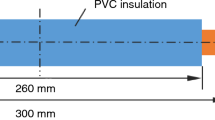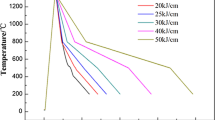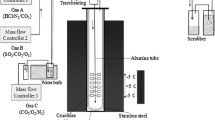Abstract
In recent years, electrical fire accidents have been frequent. Due to the lack of quantitative research on the metallographic analysis of wire melt marks, there is insufficient basis for physical evidence of identification of some electrical fires. To study the characteristics of melt marks of copper core PVC-insulated single-core flame-retardant wire short-circuit and fire-induced accidents, the electrical fault simulation experimental device was used to simulate primary and secondary short-circuit faults, and a gasoline torch was used to simulate high-temperature fire conditions and extract the metal melt marks produced by the experiments. The metallurgical microscope and Image-Pro-Plus software were used to measure the size and shape characteristics of grains and pores and to quantitatively analyze the metallurgical organization characteristics of the melt marks under different conditions. The results indicate that the primary short-circuit melt traces have fine grains with an average diameter of 13.14–17.87 μm, mainly concentrated in 0–800 μm2, dominated by dendrites with fine grain boundaries and excitation layer structure. They have fewer pores and regular shape, mainly concentrated in 0–1500 μm2. The secondary short-circuit fusion trace grains are mainly cytosolic and columnar grains, with an average diameter of 15.72–22.30 μm, mainly concentrated in 200–1200 μm2, sparse grains and coarse grain boundaries. They have more pores, larger volume, and irregular shape, mainly concentrated in 1000–3500 μm2. The fire fusion marks have coarse grain types, mainly equiaxed crystals, with average diameter mainly concentrated in 16–28 μm and grain area mainly concentrated in 600–1800 μm2. The fusion marks only have small pores or shrinkage holes distributed in the surface layer, and fewer internal pores and shrinkage holes. The results of the study can play an important role in the identification of the physical evidence of electrical fire and the determination of the cause of fire.














Similar content being viewed by others
References
Furfari FA. A history of the Van de Graaff generator. IEEE Ind Appl Mag. 2005;11(1):10–4.
Luo Y, Li Q, Jiang L, et al. Analysis of Chinese fire statistics during the period 1997–2017. Fire Saf J. 2021;125: 103400.
Jiaqing Z, Yubiao H, Xinjie Q, et al. A review on fire research of electric power grids of China: state-of-the-art and new insights. Fire Technol. 2022. https://doi.org/10.1007/s10694-022-01343-x.
Huang X, Nakamura Y. A review of fundamental combustion phenomena in wire fires. Fire Technol. 2020;56(1):315–60.
Xie D, Wang W, Lv S, et al. Visual and oxide analysis for identification of electrical fire scene. Forensic Sci Int. 2018;285:e21–4.
Babrauskas V. Electric arc explosions: a review. Fire Saf J. 2017;89:7–15.
Xu N, Ding N, Liu L, et al. Microscopic characteristics of copper wires with short-circuit molten marks in electrical fire. Mater Test. 2023;65(6):844–54.
Choi CS, Shong KM, Kim DO, et al. Analysis of dispersive characteristics and structures of copper wire melted by overcurrent. IEEJ Trans Power Energy. 2005;125(12):1327–31.
Wang W, Lu C, Shi L, et al. Numerical simulation and experimental study on metallographic structure characteristics of melting trace caused by overcurrent fault of copper wire. J Loss Prev Process Ind. 2023;83: 105065.
Yu Z, Chen S, Deng J, et al. Microstructural characteristics of arc beads with overcurrent fault in the fire scene. Materials. 2020;13(20):4521.
Zhang J, Chen T, Su G, et al. Microstructure and component analysis of glowing contacts in electrical fire investigation. Eng Fail Anal. 2022;140: 106539.
Takaki A. On the effect of thermal histories upon the metallographic structure of electric wires. Natl Res Inst Police Sci Kashiwa Jpn. 1971;24:48–56.
Jianguo Hu, Gang T, Yang Li. Metallographic identification of new copper clad aluminum wire melt marks in a fire. Fire Sci Technol. 2014;33(11):1347–50.
Jin-bao Z, Yi-kun X, Guang-ying Z, et al. Microstructure characteristics of overcurrent melt trace of aluminum alloy wire. Fire Sci Technol. 2021;40(6):932.
Xu X, Yu Z, Li Y, et al. Microstructural study of arc beads in aluminum alloy wires with an overcurrent fault. Materials. 2021;14(15):4133.
Ishibashi Y, Kishida J. Research on first and second fused mark discrimination of electric wires. In: Proceedings of the 1990 annual meeting of Japan association for fire science and engineering. 1990. vol. 1718, p. 8390.
Erlandsson R, Strand G. An investigation of physical characteristics indicating primary or secondary electrical damage. Fire Saf J. 1985;8(2):97–103.
Deng J, Li Y, Lü HF, et al. Metallurgical analysis of the ‘cause’arc beads pattern characteristics under different short-circuit currents. J Loss Prev Process Ind. 2020;68: 104339.
Lü HF, Deng J, Li Y, et al. Influence of thermal environment on metallographic structure characteristics of the electric arc bead pattern. J Loss Prev Process Ind. 2021;70: 104426.
Jiulin Li, Yang Li, Yixiang L, et al. Quantitative metallographic analysis of melting marks on aluminum alloy wires in a fire. Fire Sci Technol. 2020;39(4):565.
García-García V, Mejía I, Reyes-Calderón F. Quantitative metallographic characterization of welding microstructures in Ti-containing TWIP steel by means of image processing analysis. Mater Charact. 2019;147:1–10.
GB/T 6394-2017. Determination of average grain size of metals.
Rossi PLO, Sellars CM. Quantitative metallography of recrystallization. Acta Mater. 1997;45(1):137–48.
Li Y, Sun Y, Gao Y, et al. Analysis of overload induced arc formation and beads characteristics in a residential electrical cable. Fire Saf J. 2022;131: 103626.
Qin L, Lin S, Lin H, et al. Distribution of unfrozen water and heat transfer mechanism during thawing of liquid nitrogen immersed coal. Energy. 2023;263: 125905.
Peterson RA. Finding optimal normalizing transformations via best normalize. R J. 2021;13(1):310.
Acknowledgements
This work was supported by the National Key R & D Plan of China (2021YFE0105000), the National Natural Science Foundation of China (52074213), Shaanxi key R & D Plan Project (2021SF-472, 2022QCY-LL-70), Shaanxi Province Qin Chuangyuan “Scientists+Engineers” Team Construction (2023KXJ-052), Yulin Science and Technology Plan Project (CXY-2020-036).
Author information
Authors and Affiliations
Corresponding authors
Additional information
Publisher's Note
Springer Nature remains neutral with regard to jurisdictional claims in published maps and institutional affiliations.
Rights and permissions
Springer Nature or its licensor (e.g. a society or other partner) holds exclusive rights to this article under a publishing agreement with the author(s) or other rightsholder(s); author self-archiving of the accepted manuscript version of this article is solely governed by the terms of such publishing agreement and applicable law.
About this article
Cite this article
Wang, W., Zhao, X., Liu, Q. et al. Study on quantitative metallographic analysis method of copper wire melt trace under short-circuit and fire conditions. J Therm Anal Calorim 148, 12145–12158 (2023). https://doi.org/10.1007/s10973-023-12527-0
Received:
Accepted:
Published:
Issue Date:
DOI: https://doi.org/10.1007/s10973-023-12527-0




